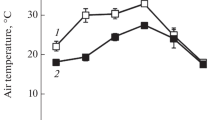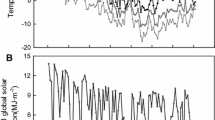Abstract
Sandy plains are characteristic of the coastal region of Brazil. We investigated the diel patterns of changes in organic acid levels, leaf conductance and chlorophylla fluorescence for sun-exposed and shaded plants ofClusia hilariana, one of the dominant woody species in the sandy coastal plains of northern Rio de Janeiro state. Both exposed and shaded plants showed a typical CAM pattern with considerable diel oscillations in organic acid levels. The degradation of both malic and citric acids during the midday stomatal closure period could lead to potential CO2 fixation rates of 28 μmol m-2 s-1 in exposed leaves. Moreover, exposed leaves exhibited large increases in total non-photochemical quenching (qN) accompanied by a substantial decrease in effective quantum yield during the course of the day. However, these potential high rates of CO2 fixation and the increases inqn of exposed plants were not enough to maintain the primary electron acceptor of photosystem II (qA) in a low reduction state, similar to that of shaded plants. As a result, there was a moderate increase in the reduction state of qA throughout the day. Most of the decline in photochemical efficiency of exposed leaves ofC. hilariana was reversible, as evidenced by the high levels of pre-dawn potential quantum yields (Fv/Fm) and their rapid recovery after sunset. However, the depletion of the organic acid pool in the afternoon resulted in an accentuated subsequent drop in Fv/Fm, suggesting that prolonged periods of water stress accompanied by high irradiance levels may expose plants ofC. hilariana in unprotected habitats to the danger of photoinhibition.
Similar content being viewed by others
References
Adams WW III, Osmond CB (1988) Internal CO2 supply during photosynthesis of sun and shade grown CAM plants in relation to photoinhibition. Plant Physiol 86: 117–123
Adams WW III, Díaz M, Winter K (1989) Diurnal changes in photochemical efficiency, the reduction state of Q, radiationless energy dissipation, and non-photochemical fluorescence quenching in cacti exposed to natural sunlight in northern Venezuela. Oecologia 80: 553–561
Björkman O, Demmig B (1987) Photon yield of O2 evolution and chlorophyll fluorescence characteristics at 77 K amongst vascular plants of diverse origins. Planta 170: 489–504
Ball E, Hann J, Kluge M, Lee HSJ, Lüttge U, Orthen B, Popp M, Schmitt A, Ting IP (1991) Ecophysiological comportment of the tropical CAM-treeClusia in the field. II. Modes of photosynthesis in trees and seedlings. New Phytol 117: 483–491
Borland AM, Griffiths H, Maxwell C, Broadmeadow MSJ, Griffiths NM, Barnes JD (1992) On the ecophysiology of the Clusiaceae in Trinidad: expression of CAM inClusia minor L. during the transition from wet to dry season and characterization of three endemic species. New Phytol 122: 349–357
Borland AM, Griffiths H, Broadmeadow MSJ, Fordham MC, Maxwell C (1993) Short-term changes in carbon-isotope discrimination in the C3-CAM intermediateClusia minor L. growing in Trinidad. Oecologia 95: 444–453
Franco AC, Ball E, Lüttge U (1990) Patterns of gas exchange and organic acid oscillations in tropical trees of the genusClusia. Oecologia 85:108–114
Franco AC, Ball E, Lüttge U (1991) The influence of nitrogen, light and water stress on CO2 exchange and organic acid accumulation in the tropical C3-CAM tree,Clusia minor. J Exp Bot 42: 597–603
Franco AC, Ball E, Lüttge U (1992) Differential effects of drought and light levels on accumulation of citric and malic acids during CAM inClusia. Plant Cell Environ 15: 821–829
Franco AC, Olivares E, Ball E, Lüttge U, Haag-Kerwer A (1994) In situ studies of Crassulacean acid metabolism in several sympatric species of tropical trees of the genusClusia. New Phytol 126: 203–211
Guralnick LJ, Heath RL, Goldstein G, Ting IP (1992) Fluorescence quenching in the varied photosynthetic modes ofPortulacaria afra (L.) Jacq. Plant Physiol 99: 1309–1313
Haag-Kerwer A (1994) Photosynthetische Plastizität beiClusia undOedematopus. Ph. D. thesis, Technische Hochschule Darmstadt
Haag-Kerwer A, Franco AC, Lüttge U (1992) The effect of temperature and light on gas exchange and acid accumulation in the C3-CAM plantClusia minor L. J Exp Bot 43: 345–352
Henriques RPB, Araújo de DSD, Hay JD (1986) Descrição e classificação dos tipos de vegetação da restinga de Carapebús, Rio de Janeiro. Rev Bras Bot 9: 173–189
Hohorst HJ (1965) L-(-)-Malat. Bestimmung mit Malatdehydrogenase und NAD. In: Bergmeyer HU (ed) Methoden der enzymatischen Analyse, 2 Auflage, Band 2. VCH, Weinheim, pp 1544–1548
Keiller DR, Slocombe SP, Cockbum W (1994) Analysis of chlorophylla fluorescence in C3 and CAM forms ofMesembryanthemum crystallinum. J Exp Bot 45: 325–334
Kluge M (1979) The flow of carbon in crassulacean acid metabolism (CAM). In: Gibbs A, Latzko E (eds) Encyclopedia of plant physiology, NS. Photosynthesis II, photosynthetic carbon metabolism and related processes, vol 6. Springer, Berlin Heidelberg New York, pp 113–125
Kooten O van, Snel JFH (1990) The use of chlorophyll fluorescence nomenclature in plant stress physiology. Photosynth Res 25: 147–150
Koster S, Winter K (1985) Light scattering as an indicator of the energy state in leaves of Crassulacean acid metabolism plantKalanchoë pinnata. Plant Physiol 79: 520–524
Krause GH, Weis E (1991) Chlorophyll fluorescence and photosynthesis: the basics. Annu Rev Plant Physiol Plant Mol Biol 42: 313–349
Long SP, Postl WF, Bolhár-Nordenkampf HR (1993) Quantum yields for uptake of carbon dioxide in C3 vascular plants of contrasting habitats and taxonomic groupings. Planta 189: 226–234
Lüttge U (1988) Day-night changes of citric-acid levels in crassulacean acid metabolism: phenomenon and ecophysiological significance. Plant Cell Environ 11: 445–451
Lüttge U (1995)Clusia: ein Modellfall der ökophysiologischen Plastizität in einer tropischen Gattung. In Bayerische Tropenforschung Einst und jetzt, Rundgespräche der Komission für Ökologie, Bayerische Akademie der Wissenschaften, vol 10. Dr Pfeil, Munich, pp 173–186
Maxwell C, Griffiths H, Borland AM, Broadmeadow MSJ, McDavid CR (1992) Photoinhibitory responses of the epiphytic bromeliadGuzmania monostachia during the dry season in Trinidad maintain photochemical integrity under adverse conditions. Plant Cell Environ 15: 37–47
Möllering H (1985) Citrate. Determination with citrate lyase, MDH and LDH. In: Bergmeyer HU (ed) Methods of enzymatic analysis, 3rd ed., vol. 7. Academic Press, New York, pp 2–12
Osmond CB (1978) Crassulacean acid metabolism: a curiosity in context. Annu Rev Plant Physiol 29: 379–414
Osmond CB, Ziegler H, Stichler W, Trimborn P (1975) Carbon isotope discrimination in alpine succulent plants supposed to be capable of crassulacean acid metabolism (CAM). Oecologia 18: 209–217
Popp M, Kramer D, Lee H, Diaz M, Ziegler H, Lüttge U (1987) Crassulacean acid metabolism in tropical dicotyledonous trees of the genusClusia. Trees 1: 238–247
Schreiber U, Bilger W (1993) Progress in chlorophyll fluorescence research: major developments during the past years in retrospect. Prog Bot 54: 151–173
Ting IP, Hann J, Holbrook NM, Putz FE, Sternberg L da SL, Price D, Goldstein G (1987) Photosynthesis in hemiepiphytic species ofClusia andFicus. Oecologia 74: 339–346
Walker D (1992) Excited leaves. New Phytol 121: 325–345
Winter K, Demmig B (1987) Reduction state of Q and nonradiative energy dissipation during photosynthesis in leaves of crassulacean acid metabolism plantKalanchoë daigremontiana Hamet et Perr. Plant Physiol 85: 1000–1007
Winter K, Lesch M (1992) Diurnal changes in chlorophylla fluorescence and carotenoid composition inOpuntia ficus-indica, a CAM plant, and in three C3 species in Portugal during summer. Oecologia 91: 505–510
Winter K, Lesch M, Díaz M (1990) Changes in xanthophyll-cycle components and in fluorescence yield in leaves of a crassulacean acid-metabolism plant,Clusia rosea Jacq., throughout a 12-hour photoperiod of constant irradiance. Planta 182: 181–185
Winter K, Zotz G, Baur B, Dietz K-J (1992) Light and dark CO2 fixation inClusia uvitana and the effects of plant water status and CO2 availability. Oecologia 91: 47–51
Zotz G, Winter K (1993) Short-term regulation of CAM activity in a tropical hemi-epiphyte,Clusia uvitana. Plant Physiol 102: 835–841
Zotz G, Winter K (1994) Annual carbon balance and nitrogen-use efficiency in tropical C3 and CAM epiphytes. New Phytol 126: 481–492
Author information
Authors and Affiliations
Rights and permissions
About this article
Cite this article
Franco, A.C., Haag-Kerwer, A., Herzog, B. et al. The effect of light levels on daily patterns of chlorophyll fluorescence and organic acid accumulation in the tropical CAM treeClusia hilariana . Trees 10, 359–365 (1996). https://doi.org/10.1007/BF02185639
Received:
Accepted:
Issue Date:
DOI: https://doi.org/10.1007/BF02185639




